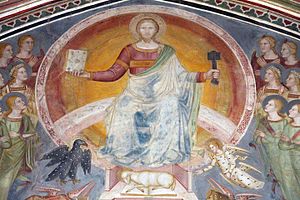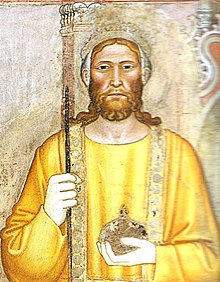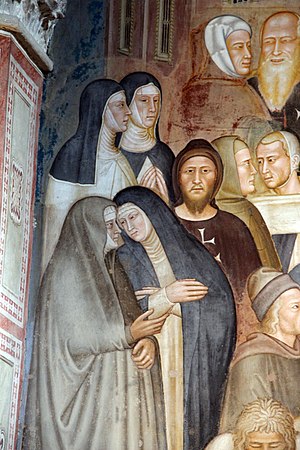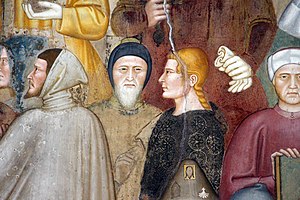
Size of this preview:
762 × 599 pixels. Other resolutions:
305 × 240 pixels |
610 × 480 pixels |
976 × 768 pixels |
1,280 × 1,007 pixels |
2,560 × 2,014 pixels |
4,851 × 3,816 pixels.
Original file (4,851 × 3,816 pixels, file size: 15.7 MB, MIME type: image/jpeg)
File history
Click on a date/time to view the file as it appeared at that time.
| Date/Time | Thumbnail | Dimensions | User | Comment | |
|---|---|---|---|---|---|
| current | 22:16, 4 March 2017 |
 | 4,851 × 3,816 (15.7 MB) | Eugene a | larger |
| 22:32, 15 January 2013 |
 | 1,800 × 1,256 (986 KB) | Michael Hurst | {{Information |Description ={{en|1=The ''Way of Salvation'' fresco is in the Spanish Chapel (Cappella Spagnuolo, or Guidalotti Chapel) of Santa Maria Novella, Florence. Created by Andrea di Bonaiuto (Andrea da Firenze), it is also known as the ''Tri... |
File usage
The following pages on the English Wikipedia use this file (pages on other projects are not listed):
Global file usage
The following other wikis use this file:
- Usage on af.wikipedia.org
- Usage on bg.wikipedia.org
- Usage on cs.wikipedia.org
- Usage on de.wikipedia.org
- Usage on es.wikipedia.org
- Usage on fr.wikipedia.org
- Usage on he.wikipedia.org
- Usage on hu.wikipedia.org
- Usage on hy.wikipedia.org
- Usage on id.wikipedia.org
- Usage on it.wikipedia.org
- Usage on ko.wikipedia.org
- Usage on la.wikipedia.org
- Usage on ms.wikipedia.org
- Usage on pt.wikipedia.org
- Usage on ro.wikipedia.org
- Usage on ru.wikipedia.org
- Usage on sl.wikipedia.org
- Usage on uk.wikipedia.org
- Usage on www.wikidata.org

Size of this preview:
762 × 599 pixels. Other resolutions:
305 × 240 pixels |
610 × 480 pixels |
976 × 768 pixels |
1,280 × 1,007 pixels |
2,560 × 2,014 pixels |
4,851 × 3,816 pixels.
Original file (4,851 × 3,816 pixels, file size: 15.7 MB, MIME type: image/jpeg)
File history
Click on a date/time to view the file as it appeared at that time.
| Date/Time | Thumbnail | Dimensions | User | Comment | |
|---|---|---|---|---|---|
| current | 22:16, 4 March 2017 |
 | 4,851 × 3,816 (15.7 MB) | Eugene a | larger |
| 22:32, 15 January 2013 |
 | 1,800 × 1,256 (986 KB) | Michael Hurst | {{Information |Description ={{en|1=The ''Way of Salvation'' fresco is in the Spanish Chapel (Cappella Spagnuolo, or Guidalotti Chapel) of Santa Maria Novella, Florence. Created by Andrea di Bonaiuto (Andrea da Firenze), it is also known as the ''Tri... |
File usage
The following pages on the English Wikipedia use this file (pages on other projects are not listed):
Global file usage
The following other wikis use this file:
- Usage on af.wikipedia.org
- Usage on bg.wikipedia.org
- Usage on cs.wikipedia.org
- Usage on de.wikipedia.org
- Usage on es.wikipedia.org
- Usage on fr.wikipedia.org
- Usage on he.wikipedia.org
- Usage on hu.wikipedia.org
- Usage on hy.wikipedia.org
- Usage on id.wikipedia.org
- Usage on it.wikipedia.org
- Usage on ko.wikipedia.org
- Usage on la.wikipedia.org
- Usage on ms.wikipedia.org
- Usage on pt.wikipedia.org
- Usage on ro.wikipedia.org
- Usage on ru.wikipedia.org
- Usage on sl.wikipedia.org
- Usage on uk.wikipedia.org
- Usage on www.wikidata.org
































